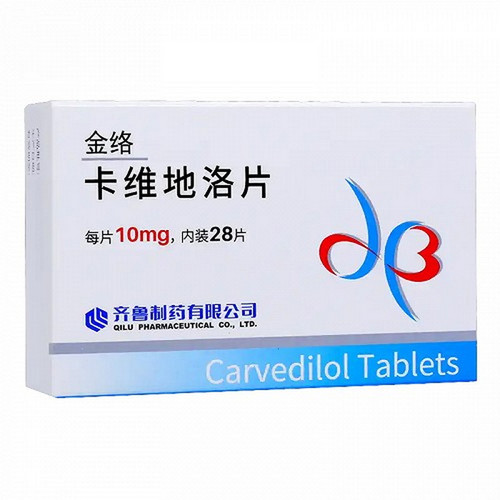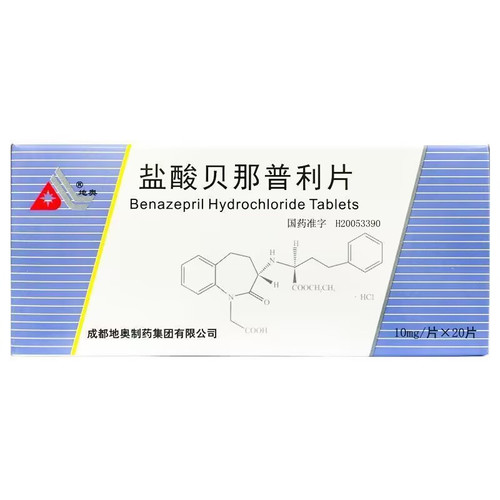Product Overview
[Drug Name]
Generic Name: Carvedilol Tablets
Trade Name: Shuheng
English Name: Carvedilol Tablets
Chinese Pinyin: Kaweidiluo Pian
[Ingredients]
The main ingredient of this product is carvedilol.
[Properties]
Active ingredient: Carvedilol. One tablet contains 12.5 mg of carvedilol. Tablets are for oral use. They are film-coated and appear white or off-white after removal of the coating.
[Indications]
1. Essential hypertension: Can be used alone or in combination with other antihypertensive drugs, especially thiazide diuretics. 2. Heart Failure: Mild or moderate heart failure (NYHA class II or III) can be treated with concomitant use of digitalis, diuretics, and angiotensin-converting enzyme inhibitors (ACEIs). It can also be used for patients with ACEI intolerance and heart failure treated with or without digitalis, hydralazine, or nitrates.
[Dosage and Administration]
The dosage must be individualized and increased under close physician supervision.
1. For hypertension, the recommended starting dose is 6.25 mg orally twice daily. If tolerated, the dose should be maintained for 7-14 days, based on standing systolic blood pressure one hour after dosing. The dose can then be increased to 12.5 mg orally twice daily, if needed, based on trough blood pressure. Similarly, the dose can be increased to 25 mg orally twice daily. A full antihypertensive effect is generally achieved within 7-14 days. The total dose should not exceed 50 mg/day. This product must be taken with food to slow absorption and reduce the risk of orthostatic hypotension. Adding a diuretic to this product or to a diuretic is expected to produce an additive effect, potentially magnifying the orthostatic effect of this product.
2. For cardiac insufficiency: Prior to using this product, the dosages of digitalis, diuretics, and ACE inhibitors (if used) must be stable. The recommended starting dose is 3.125 mg orally twice daily for 2 weeks. If tolerated, the dose can be increased to 6.25 mg twice daily. Thereafter, the dose can be doubled every 2 weeks to the maximum dose tolerated by the patient. Observe the patient for 1 hour each time a new dose is administered for dizziness or mild headache. The recommended maximum dose is 25 mg twice daily for patients <85 kg; 50 mg twice daily for patients ≥85 kg. This product must be taken with food to slow absorption and reduce the risk of orthostatic hypotension. Before each dose increase, assess for signs of cardiac dysfunction, such as worsening cardiac function, vasodilation (dizziness, mild headache, symptomatic hypotension), or bradycardia, to determine tolerance to carvedilol. Transient worsening of cardiac dysfunction can be treated with an increase in the diuretic dose, occasionally requiring a reduction or temporary discontinuation of carvedilol. Symptoms of vasodilation respond to diuretic or ACE inhibitor dose reduction; if these symptoms are not relieved, a carvedilol dose reduction may be necessary. The dose of this drug should be increased only after worsening heart failure or vasodilation symptoms have stabilized. If bradycardia (pulse <55 beats/min) occurs in patients with heart failure, the dose must be reduced.
[Adverse Reactions]
1. Hypertension: Incidence ≥ 1%, adverse events not considered causal: fatigue, bradycardia, orthostatic hypotension, postural edema, lower extremity edema, dizziness, insomnia, drowsiness, abdominal pain, diarrhea, thrombocytopenia, hyperlipidemia, back pain, viral infection, rhinitis, pharyngitis, dyspnea, and urinary tract infection. Adverse events with an incidence of >0.1% and 2% regardless of causality: hyperhidrosis, fatigue, chest pain, pain, edema, pyrexia, lower extremity edema, bradycardia, hypotension, syncope, atrioventricular block, worsening angina, dizziness, headache, diarrhea, nausea, abdominal pain, vomiting, thrombocytopenia, weight gain, gout, blood urea nitrogen increased, hyperlipidemia, dehydration, hypervolemia, back pain, arthralgia, myalgia, upper respiratory tract infection, infection, sinusitis, tracheitis, pharyngitis, urinary tract infection, hematuria, visual disturbances. Adverse events with an incidence of >1% and <2% regardless of causality: hypersensitivity, sudden death, malaise, hypovolemia, orthostatic hypotension, hypoesthesia, dizziness, melena, periodontitis, increased alanine aminotransferase and aspartate aminotransferase, hyperuricemia, hypoglycemia, hyponatremia, increased alkaline phosphatase, positive urine glucose, purpura, somnolence, abnormal renal function, albuminuria. Rare reports of aplastic anemia have occurred only with concomitant use of other medications associated with this event.
[Contraindications]
1. Patients with NYHA Class IV decompensated heart failure requiring intravenous inotropic therapy; 2. Bronchospasm (two cases of death in patients with persistent asthma after taking a single dose of carvedilol) or related bronchospastic states; 3. Second- or third-degree atrioventricular block; 4. Sick sinus syndrome; 5. Cardiogenic shock; 6. Severe bradycardia; 7. Patients with clinically severe hepatic insufficiency; 8. Hypersensitivity to this product is contraindicated; 9. Diabetic ketoacidosis or metabolic acidosis.
[Precautions]
1. Hepatic Impairment: Carvedilol is used to treat rare mild hepatocellular damage. Laboratory testing is essential at the first symptoms of liver dysfunction (such as pruritus, dark urine, persistent loss of appetite, jaundice, right upper abdominal tenderness, or unexplained flu-like symptoms). If laboratory tests confirm liver damage or jaundice, the drug must be discontinued immediately and not repeated. 2. Peripheral Vascular Disease: Beta-blockers can induce or exacerbate symptoms of arterial blood flow insufficiency in patients with peripheral vascular disease. Caution is advised in such patients. 3. Anesthesia and Major Surgery: If carvedilol is used periodically and long-term, extra caution is required when using cardiodepressant anesthetics such as ether, trimethoprim, and trichloroethylene. 4. Diabetes and Hypoglycemia: Beta-blockers may mask the symptoms of hypoglycemia, especially tachycardia. Non-selective beta-blockers may enhance insulin-induced hypoglycemia and delay the recovery of blood glucose levels. Caution should be exercised when using carvedilol in patients prone to spontaneous hypoglycemia or in diabetic patients receiving insulin or oral hypoglycemic medications. 5. Symptoms of hyperthyroidism toxicity: Beta-blockers may mask symptoms of hyperthyroidism, such as tachycardia. Abrupt discontinuation of beta-blockers may exacerbate symptoms of hyperthyroidism or induce thyroid crisis. 6. Because carvedilol has beta-blocking activity, it should not be discontinued abruptly, especially in patients with ischemic heart disease. It must be discontinued gradually over 1-2 weeks. 7. In clinical trials, carvedilol may cause bradycardia; the dose must be reduced when the pulse reaches 55 beats/minute. 8. The risk of hypotension, orthostatic hypotension, and syncope is highest within the first 30 days of treatment. To reduce the risk of these events, the initial treatment dose for patients with cardiac insufficiency is 3.125 mg twice daily; for patients with hypertension, it is 6.25 mg twice daily. The dose should be increased slowly and taken with food. During the initial treatment phase, patients must be careful to avoid situations such as driving or hazardous maneuvers. 9. Rarely, renal function may worsen in patients with cardiac impairment, particularly those with hypotension (systolic blood pressure 100 mmHg), ischemic heart disease, diffuse vascular disease, and/or underlying renal impairment. Renal function returns to baseline after discontinuation of the drug. It is recommended that renal function be monitored when increasing the dose in such patients. If renal function worsens, the dose should be discontinued or reduced. 10. During the carvedilol dose increase phase, worsening cardiac dysfunction or fluid retention may occur, necessitating increased diuretics. The carvedilol dose should not be increased until clinical stability is achieved. Occasionally, a carvedilol dose reduction or temporary discontinuation may be necessary. 11. Patients with pheochromocytoma should receive an alpha-blocker before using a beta-blocker. Although carvedilol has both beta- and alpha-blocking activity, there is no clinical experience with its use in such patients. Therefore, caution should be exercised when using carvedilol in patients with suspected pheochromocytoma. 12. Non-selective beta-blockers may induce chest pain in patients with variant angina. Although carvedilol's alpha-blocking activity may prevent the onset of angina, there is no clinical experience with its use in such patients. Therefore, caution should be exercised when using carvedilol in patients suspected of having variant angina. 13. Risk of allergic reactions: Patients with a history of severe allergic reactions to many allergens may experience more severe reactions to repeated use, and such patients may not respond to conventional doses of epinephrine used for allergy treatment. 14. Non-allergic bronchospasm (such as chronic bronchitis and emphysema) Beta-blockers are generally contraindicated in patients with bronchospastic disorders. Carvedilol should be used with caution in patients who do not respond to or cannot tolerate other antihypertensive medications, using the lowest effective dose to minimize inhibition of endogenous or exogenous beta-agonists. 15. Patient Information: ① Do not stop taking this medication abruptly without a physician's consent. ② Patients with congestive heart failure should consult a physician if they experience symptoms of worsening heart function, such as weight gain or increased dyspnea. ③ Blood pressure may drop while standing, leading to dizziness and, rarely, fainting. In these cases, sit or lie down. ④ If dizziness or fainting occurs, the patient should avoid driving or engaging in hazardous work. ⑤ If dizziness or fainting occurs and the dose needs to be adjusted, consult a physician. ⑥ Take with food. ⑦ Patients with diabetes should report any changes in blood sugar levels to their physician. ⑧ Contact lens wearers may experience tearing.
[Special Use]
Precautions for Pediatric Use: Safety and efficacy in children under 18 years of age have not been established.
Precautions for Pregnancy and Lactation: Human studies are inadequate. Carvedilol should only be used in pregnant women if the benefits to the fetus outweigh the risks. It is unknown whether it is excreted in human breast milk. Many other beta-blockers are excreted into breast milk and can cause potentially serious adverse reactions, such as bradycardia. Therefore, breastfeeding women should discontinue the drug or cease breastfeeding, considering the importance of the drug to the mother.
Elderly Precautions: Efficacy and adverse event rates do not differ between elderly and younger patients with heart failure or hypertension.
[Drug Interactions]
1. CYP2D6 Inhibitors: There are no studies on the interaction of carvedilol with CYP2D6 inhibitors (such as quinidine, fluoxetine, and paroxetine), but these drugs are expected to increase the concentration of the dextrorotatory form of carvedilol. Retrospective analyses have shown a higher incidence of dizziness during the dose-increasing period in patients with poor 2D6 metabolizers, presumably due to the vasodilatory effects of the increased concentration of the dextrorotatory form with alpha-blocking activity. 2. Catecholamine-Depleting Drugs: When carvedilol is taken concomitantly with drugs that deplete catecholamines (such as reserpine and monoamine oxidase inhibitors), the patient must be closely monitored for hypotension and/or severe bradycardia. 3. Concomitant use of carvedilol and digoxin may increase blood digoxin concentrations by 15%. 4. Concomitant use of clonidine and carvedilol may enhance the blood pressure-lowering and heart rate-reducing effects. Carvedilol should be discontinued several days before clonidine discontinuation, and the clonidine dose should then be gradually reduced until discontinuation. 5. Cyclosporine increases cyclosporine trough concentrations; the cyclosporine dose needs to be reduced to maintain therapeutic concentrations. Close monitoring of cyclosporine concentrations and appropriate dose adjustments are recommended after initiating carvedilol treatment. 6. The hepatic metabolism inducer and inhibitor, ramifenamide, reduces carvedilol plasma concentrations by 70%. Cimetidine increases carvedilol's AUC by 30%, but does not change its Cmax. 7. Conduction disturbances have been reported with the combined use of calcium channel blockers and diltiazem. As with other beta-blockers, electrocardiogram (ECG) and blood pressure monitoring are recommended when coadministered with verapamil or diltiazem-type calcium channel blockers. 8. Insulin or oral hypoglycemic drugs with β-receptor blocking activity may enhance the blood sugar-lowering effect of insulin or oral hypoglycemic drugs, so blood sugar monitoring is necessary.
[Pharmacological Action]
Within the therapeutic dose range, carvedilol exhibits both (1) and nonselective (2) receptor blocking effects, without intrinsic sympathomimetic activity. It blocks postsynaptic (1) receptors, thereby dilating blood vessels and reducing peripheral vascular resistance. Blocking (2) receptors inhibits renal secretion, disrupting the renin-angiotensin-aldosterone system and producing a hypotensive effect. Carvedilol rapidly lowers blood pressure and maintains this effect for a long time. It has no effect on left ventricular ejection fraction, cardiac function, renal function, renal perfusion, peripheral blood flow, plasma electrolytes, or lipid levels. It does not affect heart rate or may slightly slow it, and rarely causes water and sodium retention.
[Storage] Store in a dark, airtight container.
[Strength] 10 mg
[Packaging] Aluminum-plastic packaging, 20 tablets per box.
[Expiry Date] 36 months
[Approval Number] National Medicine Standard H20000101
[Manufacturer] Company Name: Ningbo Tianheng Pharmaceutical Co., Ltd., Fu'an Pharmaceutical Group








